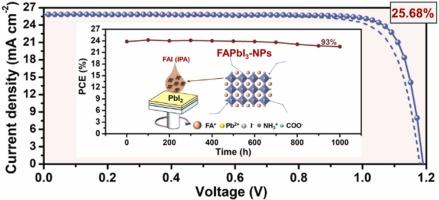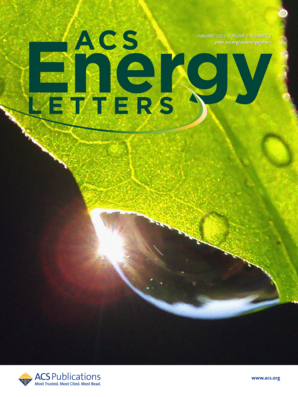FAPbI3-Nanoparticles with ligands act synergistically in absorbent layers for high-performance and stable FAPbI3 based perovskite solar cells
IF 19.3
1区 材料科学
Q1 CHEMISTRY, PHYSICAL
引用次数: 0
Abstract
The performance of perovskite solar cells (PSCs) depends on the quality of the perovskite absorber layer. In this study, oleic acid (OA) and oleylamine (OAm) ligand-capped formamidinium lead iodide (FAPbI3) nanoparticles (NPs) were incorporated into the formamidinium iodide (FAI) solution, which is one of the precursors for the sequential deposition of the FAPbI3 layer. The synergistic effect of the FAPbI3-NPs and the capped ligand substantially improves the crystallinity, uniformity, and morphology of the bulk FAPbI3 perovskite films. The enhancements lead to a reduction in charge recombination and a boost in charge transfer efficiency, enabling the optimized PSCs to achieve a remarkable peak power conversion efficiency (PCE) of 25.68%. Moreover, these PSCs show good stability, with unencapsulated devices maintaining 93% of the peak performance under ambient air (RH 50%) for 1000 hours.

带有配体的 FAPbI3 纳米粒子在吸收层中发挥协同作用,用于制造高性能、稳定的基于 FAPbI3 的过氧化物太阳能电池
过氧化物太阳能电池(PSC)的性能取决于过氧化物吸收层的质量。本研究将油酸(OA)和油胺(OAm)配体封端甲脒碘化铅(FAPbI3)纳米粒子(NPs)加入甲脒碘化铅(FAI)溶液中,该溶液是 FAPbI3 层连续沉积的前驱体之一。FAPbI3-NPs 和封端配体的协同作用大大提高了块状 FAPbI3 包晶石薄膜的结晶度、均匀性和形态。这些改进降低了电荷重组,提高了电荷转移效率,使优化后的 PSC 达到了 25.68% 的显著峰值功率转换效率 (PCE)。此外,这些 PSCs 还表现出良好的稳定性,未封装器件在环境空气(相对湿度 50% )中可保持 93% 的峰值性能达 1000 小时之久。
本文章由计算机程序翻译,如有差异,请以英文原文为准。
求助全文
约1分钟内获得全文
求助全文
来源期刊

ACS Energy Letters
Energy-Renewable Energy, Sustainability and the Environment
CiteScore
31.20
自引率
5.00%
发文量
469
审稿时长
1 months
期刊介绍:
ACS Energy Letters is a monthly journal that publishes papers reporting new scientific advances in energy research. The journal focuses on topics that are of interest to scientists working in the fundamental and applied sciences. Rapid publication is a central criterion for acceptance, and the journal is known for its quick publication times, with an average of 4-6 weeks from submission to web publication in As Soon As Publishable format.
ACS Energy Letters is ranked as the number one journal in the Web of Science Electrochemistry category. It also ranks within the top 10 journals for Physical Chemistry, Energy & Fuels, and Nanoscience & Nanotechnology.
The journal offers several types of articles, including Letters, Energy Express, Perspectives, Reviews, Editorials, Viewpoints and Energy Focus. Additionally, authors have the option to submit videos that summarize or support the information presented in a Perspective or Review article, which can be highlighted on the journal's website. ACS Energy Letters is abstracted and indexed in Chemical Abstracts Service/SciFinder, EBSCO-summon, PubMed, Web of Science, Scopus and Portico.
 求助内容:
求助内容: 应助结果提醒方式:
应助结果提醒方式:


